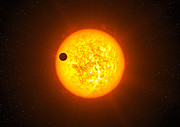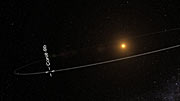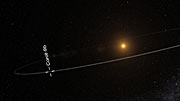Persbericht
Eerste ‘gematigde’ exoplaneet gemeten
17 maart 2010
“Dit is een normale, gematigde exoplaneet zoals we er al tientallen kennen, maar het is de eerste waarvan we de eigenschappen grondig kunnen bestuderen,” zegt Claire Moutou, lid van het internationale team van 60 astronomen dat de ontdekking deed. “Corot-9b wordt zeker de Steen van Rosetta in het onderzoek naar exoplaneten.”
“Corot-9b is de eerste exoplaneet die erg lijkt op de planeten in ons zonnestelsel,” voegt eerste auteur Hans Deeg toe. “Hij is net zo groot als Jupiter en heeft een baan vergelijkbaar met die van Mercurius.”
“De planeet bestaat voornamelijk uit waterstof en helium, net als onze reuzenplaneten Jupiter en Saturnus,” zegt teamlid Tristan Guillot, “en het is mogelijk dat Corot-9b tot 20 aardmassa’s aan andere elementen bevat, onder andere water en steen op hoge temperaturen en onder hoge druk”.
Corot-9b gaat elke 95 dagen voor zijn moederster langs, gezien vanaf de aarde [1]. Deze planeetovergang duurt ongeveer acht uur en geeft astronomen veel informatie over de planeet. Dit is gunstig omdat deze gasreus veel dezelfde kenmerken heeft als de meeste tot nu toe ontdekte exoplaneten [2].
“Onze analyse heeft meer informatie over Corot-9b opgeleverd dan over andere, vergelijkbare exoplaneten,” zegt co-auteur Didier Queloz. “Het kan een nieuw onderzoeksgebied openen om de atmosfeer van exoplaneten met een gematigde of lage temperatuur te begrijpen, en het kan vooral een geheel nieuwe blik werpen op ons begrip van de chemische processen die zich bij lage temperaturen afspelen.”
Tot nu toe zijn meer dan 400 exoplaneten ontdekt, waarvan 70 met behulp van de transit-methode. Corot-9b is bijzonder omdat de afstand tot zijn moederster ongeveer tien keer groter is dan bij de andere planeten die volgens deze methode zijn ontdekt. Bovendien is het van deze planeten de enige met een gematigd klimaat. Men vermoedt dat de oppervlaktetemperatuur ligt tussen de 160 graden en minus 20 graden Celsius, met minimale verschillen tussen dag en nacht. De precieze waarden hangen af van de eventuele aanwezigheid van een reflecterend wolkendek.
De CoRoT-satelliet, die wordt beheerd door de Franse ruimtevaartorganisatie CNES [3], identificeerde de planeet na 145 dagen waarnemen tijdens de zomer van 2008. Waarnemingen met ESO’s zeer succesvolle exoplanetenjager, de HARPS-spectrograaf op de 3,6-meter telescoop in La Silla in Chili, stelden de astronomen in staat om de massa van Corot-9b te meten. Hieruit blijkt dat Corot-9b inderdaad een exoplaneet is, met een massa van ongeveer 80% van de massa van Jupiter.
Deze conclusie wordt deze week gepubliceerd in ‘Nature’.
Noten
[1] Een planeetovergang vindt plaats wanneer een hemellichaam voor zijn moederster lang beweegt en een deel van het sterlicht tegenhoudt. Door zo’n overgang verandert de schijnbare helderheid van de ster en kan de diameter van de planeet worden gemeten. Gecombineerd met radiale snelheidsmetingen met de HARPS-spectrograaf is het ook mogelijk om de massa af te leiden en daarom ook de dichtheid van de planeet. Deze combinatie stelt astronomen in staat om het object zeer gedetailleerd te bestuderen. Het feit dat de planeet een overgang heeft – maar toch niet zo dicht om zijn ster draait als een ‘hete Jupiter’ – maakt dit object uitermate geschikt voor verdere studie.
[2] Gematigde gasreuzen zijn, tot nu toe, de grootste groep van ontdekte exoplaneten.
[3] De CoRoT (Convection, Rotation and Transits) ruimtetelescoop is gebouwd door CNES, met bijdragen van Oostenrijk, Duitsland, Spanje, België, Brazilië en de Europese ruimtevaartorganisatie ESA (European Space Agency). De telescoop is speciaal ontworpen om exoplaneetovergangen te ontdekken en seismologisch onderzoek naar sterren te doen. Zijn resultaten worden ondersteund met waarnemingen met verschillende aardse telescopen zoals de IAC-80 (Teide Obseratory), de Canada France Hawaii Telescope (Hawaii), de Isaac Newton Telescope (Roque de los Muchachos Observatory), Wise Observatory (Israël), de Faulkes North Telescope van de Las Cumbres Observatory Global Telescope Network (Hawaii) en de ESO 3,6-meter telescoop (Chile).
Meer informatie
Dit onderzoek is gepresenteerd in een paper dat deze week in ‘Nature’ wordt gepubliceerd (“A transiting giant planet with a temperature between 250 K and 430 K”), by H. J. Deeg et al.
Het team bestaat uit H.J. Deeg, B. Tingley, J.M. Almenara, en M. Rabus (Instituto de Astrofısica de Canarias, Tenerife, Spanje), C. Moutou, P. Barge, A. S. Bonomo, M. Deleuil, J.-C. Gazzano, L. Jorda, en A. Llebaria (Laboratoire d'Astrophysique de Marseille, Université de Provence, CNRS, OAMP, Frankrijk), A. Erikson, Sz. Csizmadia, J. Cabrera, P. Kabath, H. Rauer (Institute of Planetary Research, German Aerospace Center, Berlin, Duitsland), H. Bruntt, M. Auvergne, A. Baglin, D. Rouan, en J. Schneider (Observatoire de Paris-Meudon, Frankrijk), S. Aigrain en F. Pont (University of Exeter, Groot Brittanië), R. Alonso, C. Lovis, M. Mayor, F. Pepe, D. Queloz, en S. Udry (Observatoire de l'Université de Genève, Zwitzerland), M. Barbieri (Università di Padova, Italië), W. Benz (Universität Bern, Zwitzerland), P. Bordé, A. Léger, M. Ollivier, en B. Samuel (Institut d’Astrophysique Spatiale, Université Paris XI, Orsay, Frankrijk), F. Bouchy en G. Hébrard (IAP, Paris, Frankrijk), L. Carone en M. Pätzold (Rheinisches Institut für Umweltforschung an der Universität zu Köln, Duitsland), S. Carpano, M. Fridlund, P. Gondoin, en R. den Hartog (ESTEC/ESA, Noordwijk, Nederland), D. Ciardi (NASA Exoplanet Science Institute/Caltech, VS), R. Dvorak (University of Vienna, Oostenrijk), S. Ferraz-Mello (Universidade de São Paulo, Brasil), D. Gandolfi, E. Guenther, A. Hatzes, G. Wuchterl, B. Stecklum (Thüringer Landessternwarte, Tautenburg, Duitsland), M. Gillon (University of Liège, België), T. Guillot en M. Havel (Observatoire de la Côte d’ Azur, Nice, Frankrijk), M. Hidas, T. Lister, en R. Street (Las Cumbres Observatory Global Telescope Network, Santa Barbara, VS), H. Lammer en J. Weingrill (Space Research Institute, Austrian Academy of Science), en T. Mazeh en A. Shporer (Tel Aviv University, Israël).
ESO, de Europese Zuidelijke Sterrenwacht, is de belangrijkste intergouvernementele sterrenkundeorganisatie in Europa en wereldwijd het meest productieve astronomische observatorium. ESO wordt ondersteund door 14 landen: België, Denemarken, Duitsland, Finland, Frankrijk, Italië, Nederland, Oostenrijk, Portugal, Spanje, Tsjechië, het Verenigd Koninkrijk, Zweden en Zwitserland. ESO voert een ambitieus programma uit gericht op het ontwerp, de bouw en de exploitatie van krachtige grondobservatoria die astronomen in staat stellen om belangrijke wetenschappelijke ontdekkingen te doen. ESO speelt ook een leidende rol in het bevorderen en organiseren van samenwerking in het sterrenkundig onderzoek. ESO exploiteert drie observatielocaties van wereldklasse in Chili: La Silla, Paranal en Chajnantor. Op Paranal exploiteert ESO de Very Large Telescope (VLT), 's werelds meest geavanceerde optische observatorium en ESO is de Europese partner van de revolutionaire telescoop ALMA. ESO is momenteel bezig met ontwerpstudies voor de 42-meter Europese Extremely Large optische/nabij-infrarood Telescoop ( E-ELT), die ‘het grootste oog op de hemel’ ter wereld zal worden.
Links
- Onderzoekspaper
- Meer informatie: exoplanet media kit
Contact
Didier Queloz
Geneva Observatory, University of Geneva
Geneva, Switzerland
Tel: +41 22 379 2477
E-mail: didier.queloz@unige.ch
Hans J. Deeg
Instituto de Astrofísica de Canarias
Tenerife, Spain
Tel: +34 922 605 244
Mob: +34 619 360 054
E-mail: hdeeg@iac.es
Claire Moutou
Laboratoire d'Astrophysique de Marseille
Marseille, France
Tel: +33 4 91 05 59 66
E-mail: claire.moutou@oamp.fr
Henri Boffin
ESO La Silla-Paranal/E-ELT Press Officer
Garching, Germany
Tel: +49 89 3200 6222
Mob: +49 174 515 43 24
E-mail: hboffin@eso.org
Rodrigo Alvarez (press contact België)
ESO Science Outreach Network
en Planetarium, Royal Observatory of Belgium
Tel: +32-2-474 70 50
E-mail: eson-belgië@eso.org
Over dit bericht
| Persberichten nr.: | eso1011nl-be |
| Naam: | Corot-9b |
| Type: | Milky Way : Planet |
| Facility: | ESO 3.6-metre telescope, Very Large Telescope |
| Instruments: | HARPS, UVES |
| Science data: | 2010Natur.464..384D |
Our use of Cookies
We use cookies that are essential for accessing our websites and using our services. We also use cookies to analyse, measure and improve our websites’ performance, to enable content sharing via social media and to display media content hosted on third-party platforms.
ESO Cookies Policy
The European Organisation for Astronomical Research in the Southern Hemisphere (ESO) is the pre-eminent intergovernmental science and technology organisation in astronomy. It carries out an ambitious programme focused on the design, construction and operation of powerful ground-based observing facilities for astronomy.
This Cookies Policy is intended to provide clarity by outlining the cookies used on the ESO public websites, their functions, the options you have for controlling them, and the ways you can contact us for additional details.
What are cookies?
Cookies are small pieces of data stored on your device by websites you visit. They serve various purposes, such as remembering login credentials and preferences and enhance your browsing experience.
Categories of cookies we use
Essential cookies (always active): These cookies are strictly necessary for the proper functioning of our website. Without these cookies, the website cannot operate correctly, and certain services, such as logging in or accessing secure areas, may not be available; because they are essential for the website’s operation, they cannot be disabled.
Functional Cookies: These cookies enhance your browsing experience by enabling additional features and personalization, such as remembering your preferences and settings. While not strictly necessary for the website to function, they improve usability and convenience; these cookies are only placed if you provide your consent.
Analytics cookies: These cookies collect information about how visitors interact with our website, such as which pages are visited most often and how users navigate the site. This data helps us improve website performance, optimize content, and enhance the user experience; these cookies are only placed if you provide your consent. We use the following analytics cookies.
Matomo Cookies:
This website uses Matomo (formerly Piwik), an open source software which enables the statistical analysis of website visits. Matomo uses cookies (text files) which are saved on your computer and which allow us to analyze how you use our website. The website user information generated by the cookies will only be saved on the servers of our IT Department. We use this information to analyze www.eso.org visits and to prepare reports on website activities. These data will not be disclosed to third parties.
On behalf of ESO, Matomo will use this information for the purpose of evaluating your use of the website, compiling reports on website activity and providing other services relating to website activity and internet usage.
Matomo cookies settings:
Additional Third-party cookies on ESO websites: some of our pages display content from external providers, e.g. YouTube.
Such third-party services are outside of ESO control and may, at any time, change their terms of service, use of cookies, etc.
YouTube: Some videos on the ESO website are embedded from ESO’s official YouTube channel. We have enabled YouTube’s privacy-enhanced mode, meaning that no cookies are set unless the user actively clicks on the video to play it. Additionally, in this mode, YouTube does not store any personally identifiable cookie data for embedded video playbacks. For more details, please refer to YouTube’s embedding videos information page.
Cookies can also be classified based on the following elements.
Regarding the domain, there are:
- First-party cookies, set by the website you are currently visiting. They are stored by the same domain that you are browsing and are used to enhance your experience on that site;
- Third-party cookies, set by a domain other than the one you are currently visiting.
As for their duration, cookies can be:
- Browser-session cookies, which are deleted when the user closes the browser;
- Stored cookies, which stay on the user's device for a predetermined period of time.
How to manage cookies
Cookie settings: You can modify your cookie choices for the ESO webpages at any time by clicking on the link Cookie settings at the bottom of any page.
In your browser: If you wish to delete cookies or instruct your browser to delete or block cookies by default, please visit the help pages of your browser:
Please be aware that if you delete or decline cookies, certain functionalities of our website may be not be available and your browsing experience may be affected.
You can set most browsers to prevent any cookies being placed on your device, but you may then have to manually adjust some preferences every time you visit a site/page. And some services and functionalities may not work properly at all (e.g. profile logging-in, shop check out).
Updates to the ESO Cookies Policy
The ESO Cookies Policy may be subject to future updates, which will be made available on this page.
Additional information
For any queries related to cookies, please contact: pdprATesoDOTorg.
As ESO public webpages are managed by our Department of Communication, your questions will be dealt with the support of the said Department.




